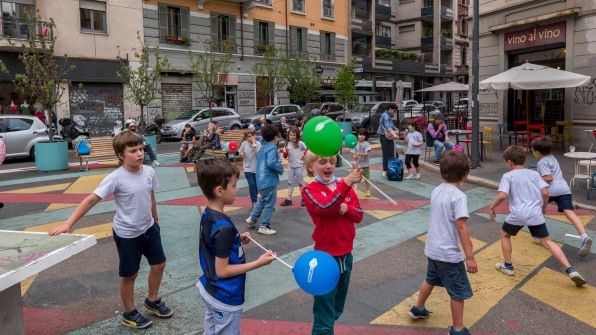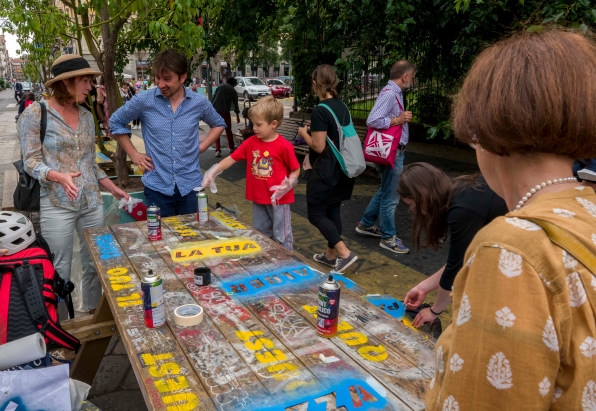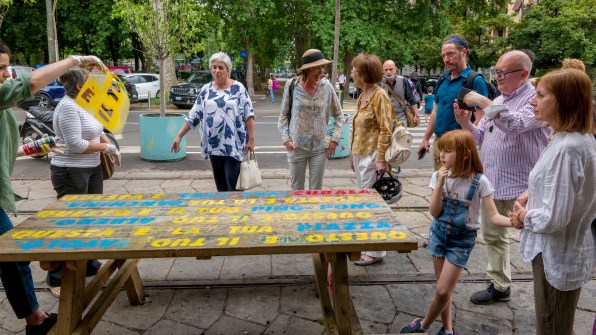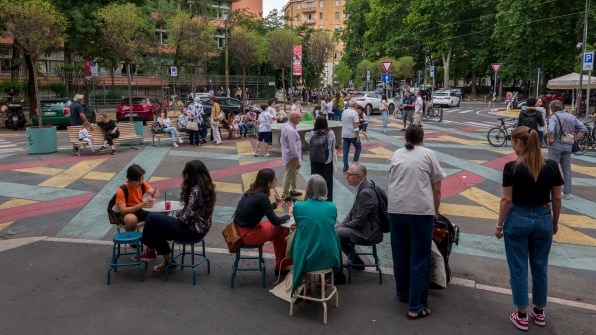Milan turned 250,000 square feet of parking into public space
There’s no way Milan could have known what was coming, but in the years leading up to the pandemic, the city was preparing as if it had seen the future.
In 2018, the city started a large-scale reinvention of its public space, focused specifically on land that was dedicated to car parking in neighborhoods that had little green space. Those spaces, with simple interventions, were converted into new public plazas. As the pandemic set in—Milan was one of the first epicenters of the outbreak in Europe—these outdoor spaces became essential lockdown escapes.

Now, as the pandemic evolves from emergency to low-level crisis, Milan’s prescient piazza program is carrying on, and setting an example for ways cities can carve new public spaces out of land they already control.
Launched as part of Mayor Giuseppe Sala’s plan to make a more resilient and livable city by 2030, the piazza creation effort has been spearheaded by Bloomberg Associates, the consulting arm of Bloomberg Philanthropies. The program is being implemented under the guidance of Janette Sadik-Khan, who served as New York City’s transportation commissioner during Michael Bloomberg’s mayoral administration and who famously led the city’s conversion of street spaces into car-free public squares. Milan’s program replicates and builds on what happened in New York.
The program started out with three piazza conversions in 2018, taking small paved areas used for street parking in underserved neighborhoods and placing benches, planters, and paint on the asphalt. Closing them off to cars, the spaces turned into parks almost overnight.

“It didn’t take years or millions of euros,” says Sadik-Khan. “We worked really fast with paintbrushes and benches to transform those parking spaces into people places.”
In 2019, 13 more piazzas were completed. More than a dozen were completed in 2020, even amid the pandemic, and more have been built since then. Each cost just about $50,000. “It’s 38 piazzas in four years,” says Sadik-Khan. “It’s an incredible amount of infrastructure, nearly a quarter-million square feet of space. And Milan has been able to keep the momentum going.”
She says more than 42 miles of streets have also been converted from car traffic to bicycle and pedestrian lanes, and the city is planning to announce its next phase of the piazza program, with more spaces being converted across the city. “Community involvement is a key part of that,” Sadik-Khan says. “Not everybody is going to be on board. Not everybody’s going to agree that there’s even a problem.”

The program did have some detractors, including local businesses worried that removing street parking would hurt their bottom line. Milan’s mayor even faced an anti-piazza challenger in his campaign for reelection last fall, but he was ultimately successful. Some businesses next to these new parks have embraced them by offering paddles and balls that people can borrow to use with the many ping-pong tables added to these plazas. “You’re starting to see the politics of the possible be a really important part of the change that’s happening in cities,” Sadik-Khan says.

The pandemic has played into these efforts, underscoring the importance of public spaces and leading to more public support during the initial planning and development process. Sadik-Khan says neighborhood groups are now lobbying for their own piazza projects.
After being unable to see the program’s expansion in person during the height of the pandemic, Sadik-Khan visited the city again in May. “It was almost like a different city from 2019,” she says.
“Today half of the people of Milan live within walking distance of public space that wasn’t there four years ago,” Sadik-Khan adds. “It didn’t just happen. It was conceived and planned and executed in really the blink of an eye for a city, using the materials that every city’s got and with streets that are already there.”
She says any city with forward-thinking leadership can follow this model, and Bloomberg Associates has made similar paint-based public plaza interventions in cities across the U.S. “Milan is showing that when you invest in your streets, you’re investing in your people,” says Sadik-Khan. “Even if you’re creating public space out of the asphalt of the street, great places in great cities are the product of urban need and urban intervention.”
(28)


